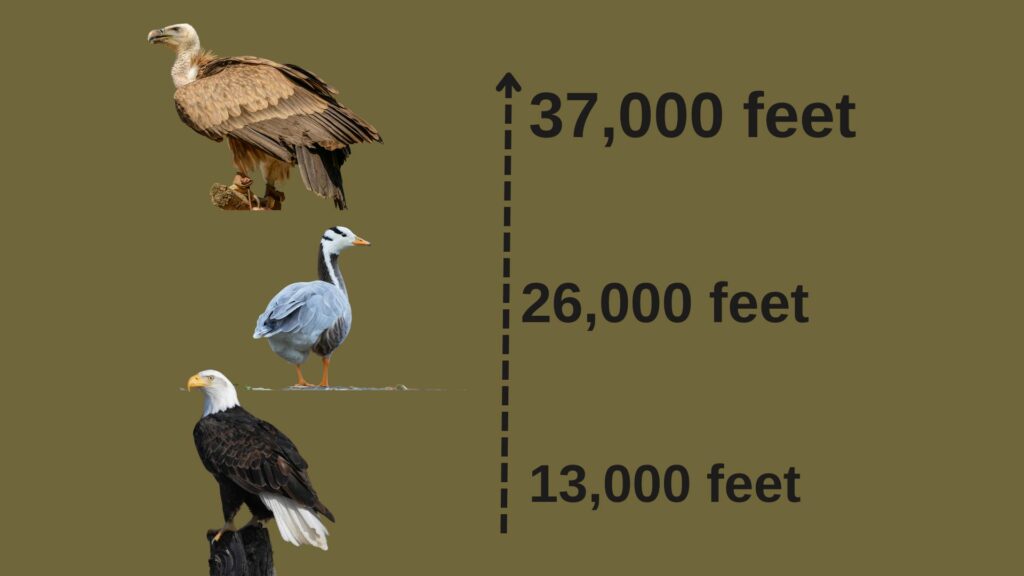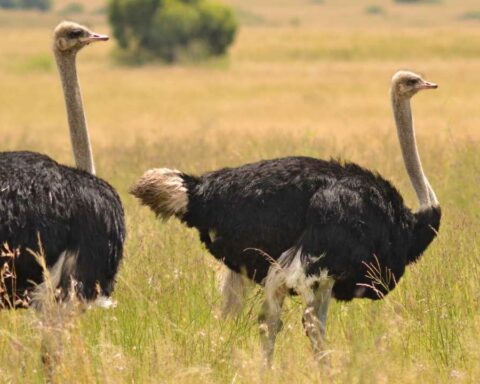Eagles, the magnificent birds of prey, have always fascinated humans with their soaring flight and keen eyesight. But have you ever wondered how high or fast an eagle can fly? Let’s explore the fascinating world of eagles and their incredible flying abilities.
How High Can An Eagle Fly?
Eagles can fly at heights between 10,000 to 20,000 feet above sea level, although this varies depending on the species. While some sources state their maximum flying height as 13,000 feet, it’s important to note that this is not the highest flying bird in the world. That title goes to the Ruppell’s Griffon vulture, which can fly at an astonishing height of 37,000 feet. Another notable high-flyer is the bar-headed goose, which can reach heights of over 26,000 feet while flying over the Himalayas.
Altitude in Meters
To convert the flying height to meters, eagles fly at average heights between 3,048 and 6,096 meters above sea level. Some sources describe their maximum flying height as 3,962 meters, but this depends on the eagle species.
Comparison with Planes
Interestingly, commercial planes usually fly between 31,000 and 38,000 feet, which is higher than the flying height of eagles. The Ruppell’s Griffon vulture, the world’s highest-flying bird, reaches heights close to commercial planes.
Specifics for Different Eagle Species
- Golden Eagle: Typically flies at altitudes of 985 to 3,937 feet (300 to 1200 meters), but can reach up to 12,000 feet.
- Bald Eagle: Usually flies over 10,000 feet high from the ground but can potentially fly higher. Hang glider pilots near California have observed them at altitudes of more than 15,000 feet.
- Sea Eagle/Fish Eagle: Includes species like the bald eagle, Madagascar fish eagle, and white-tailed eagle. While the bald eagle can fly as high as 15,000 feet, the Madagascar fish eagle can reach altitudes of 10,000 to 15,000 feet. The flying heights of other sea or fish eagle species are unknown but may range between 10,000 to 20,000 feet like most other eagle species.
- Philippine Eagle: The highest elevation at which Philippine eagles can fly is unknown, but they fly at a speed of 80 km/h (49.7 mph) and make their home in lowlands and mountains of altitudes over 1,800 meters (5,900 feet).
- Martial Eagle: Recorded to fly as high as over 5,500 meters (18,044 feet) above sea level. Sixteen martial eagles were tagged, and the transmitter data showed these heights.
How Fast Can Eagles Fly?
The speed at which eagles fly varies between species:
- Golden Eagle: Soars at a usual speed of about 45 to 52 km/h (28 to 32 mph), but when hunting or displaying, it often reaches up to 190 km/h (120 mph). When diving toward prey, their speed can reach 240 to 320 km/h (150 to 200 mph), making them one of the fastest animal species in the world.
- Bald Eagle: When gliding and flapping, their speed reaches 56 to 70 km/h (35 to 43 mph). Carrying fish reduces their speed to about 48 km/h (30 mph), and their diving speed is between 120 to 160 km/h (75 to 100 mph), although they rarely dive vertically.
On average, eagles can travel a distance of about 125 miles (201 km) in a single flight without landing. During migration, they can cover as much as 250 miles (402 km) in a day, making them one of the most long-distance flying birds.
The Mechanics of Eagle Flight
How Do Eagles Fly So Fast?
The key factors that enable eagles to fly so fast are their large wingspan, aerodynamic and sleek body shape, and powerful muscles. For example, bald and golden eagles have a maximum wingspan of up to 2.3 meters, while the white-tailed eagle and Steller’s sea eagle have wingspans of up to 2.4 and 2.5 meters, respectively. This large wingspan and aerodynamic body shape help them cut through the air with minimal effort and drag force.
How Do Eagles Fly So High and Soar?
Eagles employ several techniques to fly high without expending much energy. These include soaring, thermal updrafts, and orographic updrafts.
- Soaring: A flying style where the eagle holds its wings outward and flaps them rarely, saving considerable energy. To gain altitude, eagles depend on rising air currents instead of flapping their wings.
- Thermal Updrafts: Formed when the sun’s energy warms the air near the Earth’s surface, causing it to rise. Eagles circle inside these rising air columns to gain altitude, then glide out of the thermal air columns to fly across the landscape.
- Orographic Updrafts: Formed when air is deflected upward after hitting topographic structures like ridges, hills, and mountains. Eagles use these updrafts to glide along the topographic structures and travel a certain distance without much flapping.
The topography of a region determines an eagle’s flying height. Over mountains and hills, eagles fly at lower elevations as they use orographic updrafts, which do not allow them to gain higher altitudes. In contrast, over open valleys and grasslands, eagles gain higher altitudes due to the greater possibility of thermal updraft formation.
Why Do Eagles Fly So High?
Eagles are well-adapted to fly at high altitudes for several reasons:
- To Survey and Spot Prey: Eagles have excellent binocular vision and can see things from extremely high distances. Flying high allows them to survey a large region and locate prey.
- For Migration: Some eagle species seasonally migrate for food and water resources. Migratory birds fly high to fly quickly.
- Physical and Physiological Ability: Eagles have more enormous wings than their bodies, powerful muscles, well-made flight feathers, incredible vision, and a tendency to ride on thermals. They also have large lungs, a heavy network of blood vessels in their wings, and specially modified hemoglobin that delivers more oxygen to their bodies. These adaptations enable them to manage the energy demands and severe oxygen lack at high elevations.
Eagles are truly remarkable creatures with incredible flying abilities. Their capacity to fly at high altitudes and speeds is a testament to their physical and physiological adaptations. Whether they are soaring over mountains, gliding across open valleys, or diving at incredible rates to catch their prey, eagles continue to inspire awe and admiration in all who are fortunate enough to witness their majestic flight.










